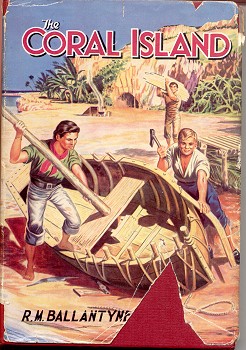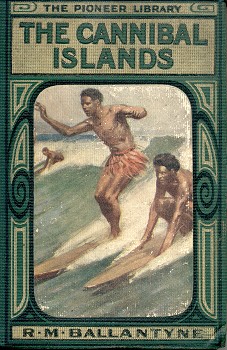surfresearch.com.au
 |
surfresearch.com.au
ballantyne : the coral island, 1858
|
R. M. Ballantyne : The Coral Island, 1858.
Ballantyne,
R.M.: The Coral Island.
Dean & Son, London.
circa early 1940s, Number 23 in the Dean's Classics'
series.
Originally published by
T. Nelson and Sons, London, 1858.
Introduction.
Ballantyne, R. M.
(Robert Michael), 1825-1894.
While
Ballantyne did not travel to the Pacific Islands before
writing The Coral Island, the text clearly indicates
that he read extensively on the subject before writing his
classic boy's adventure novel.
This would not
have been evident to most 19th century readers.
Wikipedia
notes: "...because of one mistake he had made in The
Coral Island, in which he gave an incorrect thickness
of coconut shells, Ballantyne would travel all over the
world to gain first-hand knowledge of his subject matter and
to research the backgrounds of his stories."
For his
account of Polynesian surfriding (page 175) he probably read,
at least, the published accounts of Cook's marineers in the
Hawaiian Islands (see Source Documents Hawai'i 1778 and Hawai'i 1789) and Rev.
Ellis' reports from Tahiti and Hawaii (see Source Documents Surf-riding in
the Society and Sandwich Islands).
In particular,
Ballantyne's remarks on swimming and diving (page 174) are
probably derived from Ellis.
It is also
evident that he read Charles Darwin's Journal and Remarks
1832-1835 (published 1839, commonly titled The
Voyage of the Beagle or Journal of Researches)
as Chapter XI's analysis of the volcanic formation of coral
islands has similarities with Darwin's ground breaking
research, see below.
CHAPTER XXV ...Native children's
games somewhat suprising...
Page 174
But the
amusement which the greatest number of the children of both
sexes seemed to take chief delight in was swimming and
diving in the sea, and the expertness which they exhibited
was truly amazing.
They seemed
to have two principal games in the water, one of which was
to dive off a sort of stage which had been erected near a
deep part of the sea, and chase each other in the water.
Some of them
went down to an extraordinary depth; others skimmed along
the surface, or rolled over and over like porpoises, or
diving under each other, came up unexpectedly and pulled
each other down by a leg or an arm.
They never
seemed to tire of this sport, and from the great heat of the
water in the South Seas, they could remain in nearly all day
without feeling chilled.
Many of
these children were almost infants, scarce able to walk; yet
they staggered down the beach, flung their round, fat little
black bodies fearlessly into deep water, and struck out to
sea with as much confidence as ducklings.
The other
game to which I have referred was swimming in the surf.
But as this
is an amusement in which all engage, from children of ten,
to grey-headed men of sixty, and as I had an opportunity of
witnessing it in perfection the day following, I shall
describe it more minutely.
I suppose
it was in honour of their guests that this grand
swimming-match was got up, for Romata came and told the
captain that they were going to engage in it, and begged him
to come and see."
"What sort
of amusement is this surf-swimming?" I inquired of Bill, as
we walked together to a part of the shore on which several
thousands of the natives were assembled.
"It's a very
favourite lark with these 'xtr'or'nary criters,"...
Page 175
... replied
Bill, giving a turn to the quid of tobacco that invariably
bulged out of his left cheek.
"Ye see,
Ralph, them fellows take to the water as soon a'most as they
can walk, an' long before they can do that anything
respectably, so that they are as much at home in the sea as
on the land.
Well, ye
see, I s'pose they found swimmin' for miles out to sea, and
divin' fathoms deep, wasn't exciting enough, so they
invented this game of swimmin' on the surf.
Each man and
boy, as you see, has got a short board or plank, with which
he swims out for a mile or more to sea, and then, gettin' on
the top of yon thunderin' breaker, they come to the shore on
the top of it, yellin' and screechin' like fiends.
It's a
marvel to me that they're not dashed to shivers on the coral
reef, for sure an' sartin am I that if any of us tried it,
we wouldn't be worth the fluke of a broken anchor after the
wave fell.
But there
they go! "
As he
spoke, several hundreds of the natives, amongst whom we were
now standing, uttered a loud yell, rushed down the beach,
plunged into the surf, and were carried off by the seething
foam of the retreating wave.
At the
point where we stood, the encircling coral reef joined the
shore, so that the magnificent breakers, which a recent
stiff breeze had rendered larger than usual, fell in thunder
at the feet of the multitudes who lined the beach.
For some
time the swimmers continued to strike out to sea, breasting
over the swell like hundreds of black seals.
Then they
all turned, and watching an approaching billow, mounted its
white crest, and each laying his breast on the short flat
board, came rolling towards the shore, careering on the
summit of the mighty wave, while they and the onlookers
shouted and yelled with excitement.
Just as the
monster wave curled in solemn majesty to fling its bulky
length upon the beach, most of the swimmers slid back into
the trough behind; others, slipping off their board, seized
them in their hands, and plunging through the watery waste,
swam out to repeat the amusement; but a few, who seemed to
me the most reckless, continued their career until they were
launched upon the beach, and enveloped ill the churning foam
and spray.
One of these
last came in on the crest of the wave most manfully, and
landed with a violent bound almost on the spot where Bill
and I stood.
I saw by his
peculiar head-dress that he was the chief whom the tribe ...
Page 176
...
entertained as their guest.
The
sea-water had removed nearly all the paint with which his
face had been covered, and as he rose panting to his feet, I
recognised, to my surprise, the features of Tararo, my oId
friend of the Coral Island.
CHAPTER XI ... Questions on the
formation of coral islands...
Page 76
Besides
this, I noticed that on the summit of the high mountain,
which we once more ascended at a different point from our
first climb, were found abundance of shells and broken coral
formations; which Jack and I agreed proved either that this
island mnst have once been under the sea, or that the sea
must once have been above the island.
In other
words, that as shells and coral ...
Page 77
... could
not possibly climb to the mountain-top, they must have been
washed upon it while the mountain-top was on a level with
the sea.
We pondered
this very much; and we put to ourselves the question, "What
raised the island to its present height above the sea?"
But to this
we could by no means give to ourselves a satisfactory reply.
Jack thought
it might have been blown up by a volcano; and Peterkin said
he thought it must have jumped up of its own accord!
We also
noticed, what had escaped us before, that the solid rocks of
which the island was formed were quite different from the
live coral rocks on the shore, where the wonderful little
insects were continually working.
They seemed,
indeed, to be of the same material - a substance like
limestone; but while the coral rocks were quite full of
minute cells in which the insects lived, the other rocks
inland were hard and solid, without the appearance of cells
at all.
Our thoughts
and conversations on this subject were sometimes so profound
that Peterkin said
we should
certainly get drowned in them at last, even although we were
such good divers! Nevertheless we did not allow his
pleasantry on this and similar points to deter us from
making our notes and observations as we went along.
R.M. Ballantyne: Wikipedia Bibliography
http://en.wikipedia.org/wiki/Robert_Michael_Ballantyne
The Coral
Island: Wikipedia
http://en.wikipedia.org/wiki/The_Coral_Island
|
|
Ballantyne,
R.M.: The Coral Island.
Dean & Son, London.
circa early 1940s, Number 23 in the Dean's
Classics' series.
Originally published by
T. Nelson and Sons, London,
1858.
R.M. Ballantyne:
The
Cannibal Islands -
Captain
Cook's Adventures in the South Seas.
Nisbet
and Co. Ltd., 22 Berners Street, London, circa 1880.
Cover
paste down and Frontpiece.
"The Natives Playing in the
Water."
Artist
Unknown.
|
|

surfresearch.com.au
Geoff Cater (2009-2018) :
R.M. Ballantyne : The Coral Island, 1858.
http://www.surfresearch.com.au/1858_Ballantyne_Coral_Island.html


